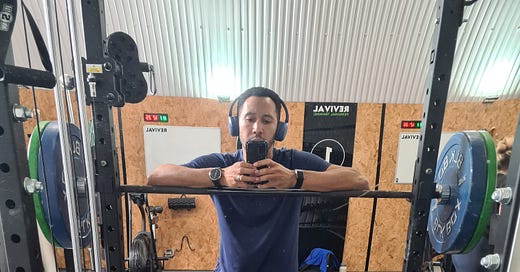“Train movements, not muscles.” – Dan John
If you’ve been around gyms long enough, you’ve probably come across the famous ‘body part split’ strategy: chest and triceps on Monday, back and biceps Tuesday, legs on Wednesday - maybe deltoids and forearms on Thursday if you’re feeling more ‘gym-bro’ than usual. Are you familiar?
I’ll be honest, I used to be an advocate.
On the football pitch I looked like an athlete, really I was more like a kitted out bodybuilder.
This kind of split routine has been a gym floor staple for decades. And for some goals (pure hypertrophy, or actual bodybuilding competition) it can be effective. For me it used to look like:
Mon - Chest / Triceps
Tues - Back / Biceps
Weds - Legs / Shoulders
Thurs - Cardio
Fri or Sat - Total Body
Sunday - Football match
But our health and performance philosophy surely needs to go deeper than just sculpting individual muscle groups - which this kind of approach can absolutely achieve. We are in need of the support networks that allow us to create and nurture high-performing, resilient, and capable human beings.
That’s why years ago I switched to a different approach.
Nowadays for me, every session requires the whole body. Sometimes high intensity (in volume, or load, or both), sometimes low intensity, sometimes nothing at all (did you notice my previous lack of appreciation for a rest day?!). Now it looks more like this:
Mon - REST (assuming I played Football the day before).
Tue - HIGH: Speed/Plyometrics & Max Strength (lower), whole body weak point training.
Wed - LOW: Usually a home workout. Light weights, 10-15 reps. Mobility. Activation. An easy jog could go here too.
Thurs - HIGH: Max Strength (upper) & core stability.
Fri - HIGH: Power (lower), Speed intervals, weak point training.
Sat - REST or some tlc, mobility, activation etc.
Sun - FOOTBALL.
3 ‘Low’ days where I either totally rest, or do an easy, low intensity resistance training workout. 4 days where I either move really fast, lift really heavy, or bust my lungs.
Let’s explore why moving away from body part splits is a smarter, more complete way to train.
Why Split Routines Fall Short
Split routines are muscle-centric. They isolate muscle groups and often neglect the most essential element of human performance: synergy and coordination. When you train like this, it’s easy to fall into a pattern where you prioritise certain muscles and conveniently forget others (we’ve all seen the ‘triangular lad’ with the massive torso and tiny legs).
The truth is, your body doesn’t function in isolated compartments. You don’t walk using your quads alone, or jump with just your calves.
You move as a unit.
Every athletic movement we value - whether it's sprinting, lifting, rotating, or changing direction - demands that your muscles work together, not in isolation. They need to flow like an orchestra, harmonising a symphony of simultaneous upper and lower body actions, leveraging each other, one joint stabilising while another explodes into concentric contraction, just as a third lengthens to decelerate you, contracting eccentrically with perfect timing.
You can’t blag this. It requires practice.
Training a chest day and a back day is not how life works. Training the body as a system, is.
My Approach: Alternating Intensity, Always Moving
This model is built around a simple principle: train the system, that is your body, in every session, and manipulate intensity to ensure the appropriate state of readiness.
High intensity days are where we push performance:
Plyometrics – Jumping, skipping, sprinting, bounding
Heavy Lifting – 75%+ of your 1-rep max, working in the 1–8 rep range
Interval Training – High effort, short bursts, challenging different energy systems
Explosiveness – Throws, speed-strength. Training the nervous system to be fast, reactive, powerful.
These elements build strength, speed, and athleticism.
Low intensity days are not always ‘easy’ - but they are intentionally lower in load and stress on the central nervous system:
Stability & Balance Work – Think single-leg movements, rotational control
Mobility & Coordination – Restoring range of motion, syncing the kinetic chain
Light Resistance – Higher reps, slower tempo, perfect form
Recovery Focused – These sessions enable progress by supporting tissue repair and nervous system recovery
Think of these sessions as the glue that holds everything together. They’re essential for long-term gains and injury reduction we crave.
The Science of Synergy
Your body’s movement system is complex, but at its core, it’s beautifully simple: everything is connected. When we train the entire body regularly, and with intent, we develop:
Better neuromuscular coordination
Improved joint stability
Reduced risk of injury
More functional strength
A more balanced physical development (no more twiglet legs!)
You’re no longer just chasing pump, soreness and visible abs - you’re pursuing true human capability.
If you’re currently doing a split routine, try shifting to 3 workouts a week that collectively fill all the fitness buckets - speed, power, strength, hypertrophy, endurance, threshold etc. Rotate between high and low intensity, and cover the major human actions:
Squat
Hinge
Push
Pull
Lunge
Carry
Rotate
Jump
Throw
Sprint
Use heavy loads on high-intensity days, and slow, controlled movement with lighter loads on low-intensity days. Think about quality and intention of movement, not just quantity of reps.
Know someone who still trains like it's 2005? Forward them this newsletter.
Want to move better, get stronger, and train like you were built to move?




